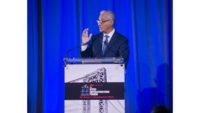Gensler, far and away the largest architectural practice, has two people as co-CEOs—and while it has operated that way for about two decades, there seems to be growing interest in the idea.
The Los Angeles-based company leads all other reporting designers in Architectural Record's current ranking of the Top 300 Architectural Firms based on 2023 revenue. The rankings are assembled from data collected by ENR for its top lists.
Two weeks ago, Gensler announced that it had named Elizabeth Brink as co-CEO of "the world’s preeminent architecture and design firm," joining Jordan Goldstein, who assumed the role last year.
Both are veteran Gensler employees and will retain their current positions as co-managing directors, with Brink overseeing the Southwest region and Goldstein the Southeast. Their predecessors, Diane Hoskins and Andy Cohen, who held the co-CEO roles for nearly 20 years, were named in 2023 to new roles as board co-chairs, the company reported.
Gensler, at $1.83 billion in 2023 revenue, and Chicago-based Perkins&Will, with $706 million, again are ranked first and second for the fifth year in a row.
HKS reported $566 million in architecture revenue, making it the third highest firm on the list, with HDR ranked fourth at $496 million and AECOM fifth with $479 million.
According to the ENR data, total architectural revenue fell between 2020 and 2021—the heart of the pandemic—but has shot up in the past two years. Total Top 300 architectural revenue was $19.76 billion in 2023.
Last year, interiors architect H. Hendy Associates appointed two longtime managers, Susan Dwyer and Carolina Weidler, as co-CEOS of the Newport Beach, Calif.-based firm. The promotions came as part of a transition that involved an employee stock ownership program. In addition, HOK, a prominent architectural practice formally appointed Eli Hoisington and Susan Klumpp Williams, as co-CEOs, succeeding firm co-founder Bill Hellmuth, after his death.
Harvard Business Review, In a 2022 article, asked whether "Is it time to consider co-CEOs?" The article, with three authors, was based on research of 87 companies then led by co-CEOs that showed how they "tended to generate better returns than their peer companies" with a sole CEO.






